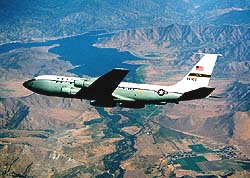| . |  |
. |
 Edwards AFB - January 19, 2000 - There are many places from which scientists can analyze cloud moisture. For example, take tropical islands and their reliable afternoon showers. Or perhaps more conveniently, there's every outdoor Starbucks caf� in Seattle. But for some researchers, the ideal spot is Edwards.
Edwards AFB - January 19, 2000 - There are many places from which scientists can analyze cloud moisture. For example, take tropical islands and their reliable afternoon showers. Or perhaps more conveniently, there's every outdoor Starbucks caf� in Seattle. But for some researchers, the ideal spot is Edwards.Why here in the Mojave Desert, which receives less than five inches of rain annually? The answer: 452nd Flight Test Squadron-owned aircraft that can transport scientists and data-gathering equipment above diverse terrain and through various climate conditions found along the West Coast. "We periodically stage out of Edwards for our studies because a 452nd aircrew can take us over the desert, along the ocean and around mountainous and flat areas during a typical flight," said Dave Johnson, project coordinator with Space Dynamics Laboratory at Utah State University. Plus, he said, the base is perfect for research flight because "you don't have to worry about missions being canceled due to bad weather." SDL is a recognized leader in designing and testing radiometers and other electro-optical sensors. Its experience includes developing and flying infrared instruments aboard aircraft laboratories, sounding rockets, space shuttle payloads and satellites. Overall, SDL's mission is researching remote-sensing and measurement systems. For the latter, it teamed up here with the Russian Vavilov State Optical Institute to assess cloud structures while using modified NKC-135E tankers called Flight Infrared Signature Technology Aircraft. Vavilov, located in St. Petersburg, studies fields such as photo physics, thermal vision technology, aerospace optics and laser ranging. Johnson labeled it the "premier" remote-sensing institute in Russia. During the recent two-week studies here, members from Vavilov, SDL and the Air Force Research Laboratory at Hanscom Air Force Base, Mass., flew six missions aboard FISTA, collecting data with eight devices, including a Russian aquameter. This infrared apparatus, which is sensitive to water content in clouds, gathered information for scientists to study atmosphere spectro-brightness. "This process helps us to finitely gauge temperatures and moisture content at various altitudes," said Dr. Valentin Solovyev, chief of Vavilov's thermal imaging system section. These airborne studies from Edwards are part of a collaborative technology development program called the Russian-American Observational Satellites, Johnson said. Sponsored by the Ballistic Missile Defense Organization, RAMOS is a long-term data collection and analysis effort that, in final form, may feature two remote sensing satellites -- one Russian, one U.S. They will provide measurement data, often acquired simultaneously, to analysts in both countries. RAMOS is divided into two phases. Phase One, called Near-Term Experiments, is a series of studies and pathfinder testing using existing assets, such as the 452nd's FISTA. "Hopefully, Phase One's end result will be the deployment and operation of the satellites for stereo-optical imaging (Phase Two), which would address shared concerns in surveillance and environmental monitoring," said Dmitry Chvanov, a Russian representative with SDL. Two satellites in near identical orbits would provide a three-dimensional image, which Johnson believes will provide scientists early views of natural phenomena such as hurricanes, cyclones and tsunamis. It also could provide more information of existing weather. "For example," Johnson explained, "it would be nice to know the wind speeds inside a hurricane without having to fly through it and then be able predict its path and the velocity of its destructive power." Furthermore, Johnson and Chanov said there is some "military applicability," such as spotting rocket plumes and then determining the point, time, speed and direction of a launch -- even through thick cloud cover.
Additionally, the two researchers said research instruments flown aboard aircraft here could provide the scientific foundation for other devices that will eventually be developed for RAMOS.
MILSPACE
|
| |||||||||
| The content herein, unless otherwise known to be public domain, are Copyright 1995-2016 - Space Media Network. All websites are published in Australia and are solely subject to Australian law and governed by Fair Use principals for news reporting and research purposes. AFP, UPI and IANS news wire stories are copyright Agence France-Presse, United Press International and Indo-Asia News Service. ESA news reports are copyright European Space Agency. All NASA sourced material is public domain. Additional copyrights may apply in whole or part to other bona fide parties. Advertising does not imply endorsement, agreement or approval of any opinions, statements or information provided by Space Media Network on any Web page published or hosted by Space Media Network. Privacy Statement All images and articles appearing on Space Media Network have been edited or digitally altered in some way. Any requests to remove copyright material will be acted upon in a timely and appropriate manner. Any attempt to extort money from Space Media Network will be ignored and reported to Australian Law Enforcement Agencies as a potential case of financial fraud involving the use of a telephonic carriage device or postal service. |